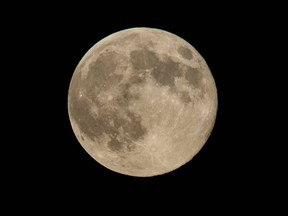The evening sky in August performs host to 2 full moons (one in every of them blue!) and the summer season’s finest meteor bathe

Article content material
Look! Up within the sky! It’s the moon! It’s a supermoon! It’s superbluemoon!
Commercial 2
Article content material
August brings its share of astronomical wonders. A few of them — just like the Perseid meteor bathe on Aug. 13, or the Kappa Cygnid bathe 5 days later — are annual occasions. Others, reminiscent of two supermoons and a blue moon, occur at numerous occasions of the 12 months.
Article content material
What’s a supermoon?
It’s not an official astronomical time period. The truth is, it was coined by an astrologer, Richard Nolle, in 1979, to confer with a full moon that takes place whereas the moon is close to its closest level to the Earth. If you would like the flowery astronomy time period, it’s a perigee-syzygy of the Earth/moon/solar.
Like all astronomical our bodies, the moon orbits in an ellipsis that takes it from about 360,000 km away from the Earth (perigee) to about 405,000 km away (apogee). The distinction implies that a full moon at perigee can look 14 per cent larger and about 30 per cent brighter than one at perigee.
Commercial 3
Article content material
The moon reaches its closest level to the Earth on Aug. 2, and once more on Aug. 30. That’s shut sufficient to the complete moons of Aug. 1 and Aug. 31 to make them supermoons. They’re straightforward to see, rising shortly after sundown all throughout Canada.
Whereas lovely, supermoons should not way more spectacular than common full moons – any movies you’ve seen on-line of the moon filling half the sky are simply hokum. And whereas Nolle notes that the Christchurch earthquake, Hurricane Katrina and the Mt. Pinatubo eruption all came about on (or close to) a supermoon – nicely, that’s what’s often called an excellent coincidence.
So what’s a blue moon?
That is one other non-astronomical time period, and refers back to the second full moon in a calendar month. Because it takes about 29.5 days to go from one full moon to the following, each month (besides February) can have a second full moon if the primary one arrives within the first day or two. (It’s not really blue, nevertheless.)
Commercial 4
Article content material
In accordance with the Encyclopedia Brittanica, the time period “blue moon” began getting used within the early 1900s to confer with a fourth full moon in any three-month season. Then in 1946, an article in Sky & Telescope journal mistook it to imply the second full moon in a month, and that definition caught.
The phrase “as soon as in a blue moon” refers to one thing very uncommon, however blue moons aren’t super-rare, averaging out to 1 each 33 months, or 41 occasions a century. That stated, 2018 had a uncommon “double blue moon,” with a blue moon in January and one other in March. The following time that occurs will likely be in 2037. The following common blue moon will likely be in Could of 2026.
What concerning the Perseid meteor bathe?
The Perseids, so named as a result of the meteors appear to originate close to the constellation Perseus within the northeast, is among the brightest of the annual meteor showers. (It’s additionally one of many warmer-weather ones, versus, say, the Geminids, which occur in mid-December.)
Commercial 5
Article content material
The meteors come from particles from comet Swift-Tuttle. Too small to succeed in the bottom, they’re however seen in numbers of as much as one per minute, though the very best viewing is as removed from metropolis lights as potential. Excellent news this 12 months — peak exercise is the evening of Aug. 13, simply three days earlier than the brand new moon, which means there gained’t be a lot interference from the moon’s glow.
And the kappa Cygnids?
Whereas the Perseids are a Class I meteor bathe, producing tens of meteors (or extra) each hour, Class II showers just like the kappa Cygnids would possibly max out at simply 5 per hour. Nonetheless, should you’re outdoors in a darkish place, it by no means hurts to search for.
-

Here is how Earth nearly ended up with a 60-hour day
-

Earth obtained a brand new moon 2,100 years in the past. Astronomers simply discovered it
Feedback
Postmedia is dedicated to sustaining a full of life however civil discussion board for dialogue and encourage all readers to share their views on our articles. Feedback could take as much as an hour for moderation earlier than showing on the location. We ask you to maintain your feedback related and respectful. We have now enabled e mail notifications—you’ll now obtain an e mail should you obtain a reply to your remark, there’s an replace to a remark thread you comply with or if a consumer you comply with feedback. Go to our Group Tips for extra data and particulars on regulate your e mail settings.
Be part of the Dialog